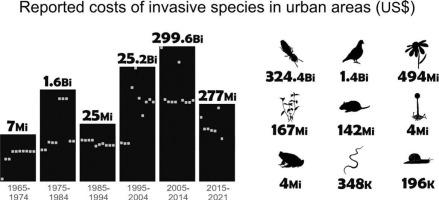当前位置:
X-MOL 学术
›
Sci. Total Environ.
›
论文详情
Our official English website, www.x-mol.net, welcomes your
feedback! (Note: you will need to create a separate account there.)
Economic costs of invasive non-native species in urban areas: An underexplored financial drain
Science of the Total Environment ( IF 8.2 ) Pub Date : 2024-01-26 , DOI: 10.1016/j.scitotenv.2024.170336 Gustavo Heringer 1 , Romina D Fernandez 2 , Alok Bang 3 , Marion Cordonnier 4 , Ana Novoa 5 , Bernd Lenzner 6 , César Capinha 7 , David Renault 8 , David Roiz 9 , Desika Moodley 5 , Elena Tricarico 10 , Kathrin Holenstein 11 , Melina Kourantidou 12 , Natalia I Kirichenko 13 , José Ricardo Pires Adelino 14 , Romina D Dimarco 15 , Thomas W Bodey 16 , Yuya Watari 17 , Franck Courchamp 18
Science of the Total Environment ( IF 8.2 ) Pub Date : 2024-01-26 , DOI: 10.1016/j.scitotenv.2024.170336 Gustavo Heringer 1 , Romina D Fernandez 2 , Alok Bang 3 , Marion Cordonnier 4 , Ana Novoa 5 , Bernd Lenzner 6 , César Capinha 7 , David Renault 8 , David Roiz 9 , Desika Moodley 5 , Elena Tricarico 10 , Kathrin Holenstein 11 , Melina Kourantidou 12 , Natalia I Kirichenko 13 , José Ricardo Pires Adelino 14 , Romina D Dimarco 15 , Thomas W Bodey 16 , Yuya Watari 17 , Franck Courchamp 18
Affiliation

|
Urbanization is an important driver of global change associated with a set of environmental modifications that affect the introduction and distribution of invasive non-native species (species with populations transported by humans beyond their natural biogeographic range that established and are spreading in their introduced range; hereafter, invasive species). These species are recognized as a cause of large ecological and economic losses. Nevertheless, the economic impacts of these species in urban areas are still poorly understood. Here we present a synthesis of the reported economic costs of invasive species in urban areas using the global database, and demonstrate that costs are likely underestimated. Sixty-one invasive species have been reported to cause a cumulative cost of US$ 326.7 billion in urban areas between 1965 and 2021 globally (average annual cost of US$ 5.7 billion). Class Insecta was responsible for >99 % of reported costs (US$ 324.4 billion), followed by Aves (US$ 1.4 billion), and Magnoliopsida (US$ 494 million). The reported costs were highly uneven with the sum of the five costliest species representing 80 % of reported costs. Most reported costs were a result of damage (77.3 %), principally impacting public and social welfare (77.9 %) and authorities-stakeholders (20.7 %), and were almost entirely in terrestrial environments (99.9 %). We found costs reported for 24 countries. Yet, there are 73 additional countries with no reported costs, but with occurrences of invasive species that have reported costs in other countries. Although covering a relatively small area of the Earth's surface, urban areas represent about 15 % of the total reported costs attributed to invasive species. These results highlight the conservative nature of the estimates and impacts, revealing important biases present in the evaluation and publication of reported data on costs. We emphasize the urgent need for more focused assessments of invasive species' economic impacts in urban areas.
中文翻译:

城市地区非本地入侵物种的经济成本:尚未充分探讨的资金流失
城市化是全球变化的一个重要驱动力,与一系列环境变化相关,这些环境变化影响入侵性非本地物种的引入和分布(由人类迁移到超出其自然生物地理范围的种群的物种,这些物种在其引入范围内建立并正在传播;此后) ,入侵物种)。这些物种被认为是造成巨大生态和经济损失的原因。然而,人们对这些物种对城市地区的经济影响仍然知之甚少。在这里,我们使用全球数据库综合报告了城市地区入侵物种的经济成本,并证明成本可能被低估。据报道,1965 年至 2021 年间,61 种入侵物种在全球城市地区造成的累计损失达 3,267 亿美元(年平均损失为 57 亿美元)。昆虫纲占报告成本的 99% 以上(3,244 亿美元),其次是禽类(14 亿美元)和木兰纲(4.94 亿美元)。报告的成本极不平衡,五个最昂贵物种的总和占报告成本的 80%。大多数报告的成本是由损害造成的(77.3%),主要影响公共和社会福利(77.9%)以及当局利益相关者(20.7%),并且几乎全部发生在陆地环境中(99.9%)。我们发现 24 个国家报告的成本。然而,还有 73 个国家没有报告造成的损失,但出现了入侵物种,并报告了其他国家造成的损失。尽管城市地区覆盖地球表面相对较小的区域,但它约占报告的入侵物种造成的总损失的 15%。 这些结果凸显了估计和影响的保守性,揭示了成本报告数据的评估和发布中存在的重要偏差。我们强调迫切需要对入侵物种对城市地区的经济影响进行更有针对性的评估。
更新日期:2024-01-26
中文翻译:

城市地区非本地入侵物种的经济成本:尚未充分探讨的资金流失
城市化是全球变化的一个重要驱动力,与一系列环境变化相关,这些环境变化影响入侵性非本地物种的引入和分布(由人类迁移到超出其自然生物地理范围的种群的物种,这些物种在其引入范围内建立并正在传播;此后) ,入侵物种)。这些物种被认为是造成巨大生态和经济损失的原因。然而,人们对这些物种对城市地区的经济影响仍然知之甚少。在这里,我们使用全球数据库综合报告了城市地区入侵物种的经济成本,并证明成本可能被低估。据报道,1965 年至 2021 年间,61 种入侵物种在全球城市地区造成的累计损失达 3,267 亿美元(年平均损失为 57 亿美元)。昆虫纲占报告成本的 99% 以上(3,244 亿美元),其次是禽类(14 亿美元)和木兰纲(4.94 亿美元)。报告的成本极不平衡,五个最昂贵物种的总和占报告成本的 80%。大多数报告的成本是由损害造成的(77.3%),主要影响公共和社会福利(77.9%)以及当局利益相关者(20.7%),并且几乎全部发生在陆地环境中(99.9%)。我们发现 24 个国家报告的成本。然而,还有 73 个国家没有报告造成的损失,但出现了入侵物种,并报告了其他国家造成的损失。尽管城市地区覆盖地球表面相对较小的区域,但它约占报告的入侵物种造成的总损失的 15%。 这些结果凸显了估计和影响的保守性,揭示了成本报告数据的评估和发布中存在的重要偏差。我们强调迫切需要对入侵物种对城市地区的经济影响进行更有针对性的评估。











































 京公网安备 11010802027423号
京公网安备 11010802027423号